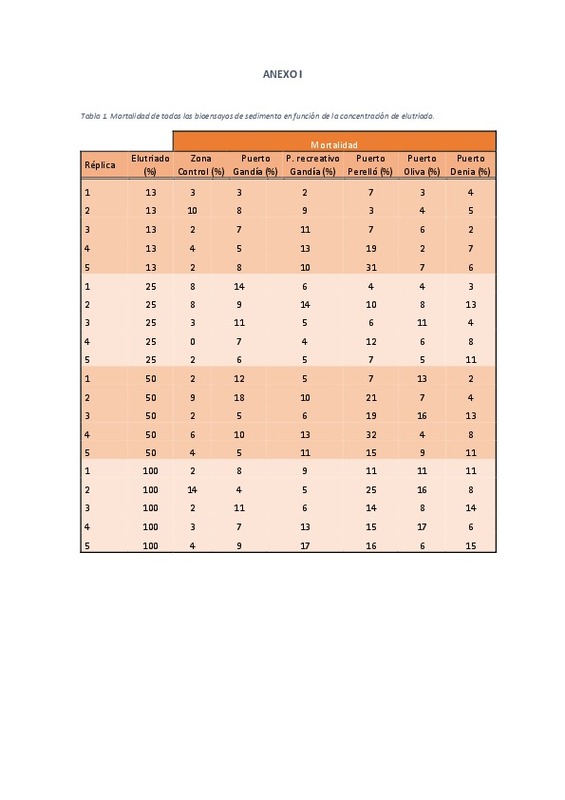JavaScript is disabled for your browser. Some features of this site may not work without it.
Buscar en RiuNet
Listar
Mi cuenta
Estadísticas
Ayuda RiuNet
Admin. UPV
Toxicidad de sedimentos marinos procedentes de puertos
Mostrar el registro sencillo del ítem
Ficheros en el ítem
| dc.contributor.advisor | Falco Giaccaglia, Silvia Laura
|
es_ES |
| dc.contributor.author | Andrés Rodríguez, Bryan
|
es_ES |
| dc.date.accessioned | 2021-10-19T11:58:01Z | |
| dc.date.available | 2021-10-19T11:58:01Z | |
| dc.date.created | 2021-09-24 | |
| dc.date.issued | 2021-10-19 | es_ES |
| dc.identifier.uri | http://hdl.handle.net/10251/174981 | |
| dc.description.abstract | [ES] Los sedimentos marinos juegan un gran papel en el ecosistema ya que no solo son el soporte de la flora; la cual conforma el hábitat de las especies bentónicas, sino que también le aporta gran variedad de nutrientes. Desde la creación y uso de los puertos, estas áreas que delimitan la costa y el mar han recibido una gran influencia procedente de la actividad humana. Debido a estos cambios los sedimentos comienzan a absorber las substancias que se desprenden de estas actividades. Por tanto, y para saber si el sedimento ha alcanzado concentraciones de contaminantes lo suficientemente tóxicas como para ser preocupantes se ha decidido analizar su toxicidad general a través del protocolo estandarizado: ¿Protocolo del test de toxicidad de sedimentos marinos con larvas del erizo de mar Paracentrotus lividus (Lamarck, 1816)¿. Este test se ha aplicado a los sedimentos del Puerto de Gandía, del Puerto recreativo de Gandía, del Puerto del Perelló, del Puerto de Oliva y del Puerto de Denia. Siguiendo la metodología descrita podemos concluir que se han visto afectadas las longitudes de las larvas en todos los puertos, destacando el Puerto del Perelló y el de Oliva. Siendo el Puerto del Perelló el de mayor densidad de embarcaciones seguido por el de Oliva el cual, además, también recibe aportaciones de sedimentos provenientes de la Albufera. | es_ES |
| dc.description.abstract | [EN] Marine sediments play a great role in the ecosystem since they are not only the support of the flora; which forms the habitat of benthic species, but also provides a great variety of nutrients. Since the creation and use of ports, these areas that delimit the coast and the sea have been greatly influenced by human activity. Due to these changes, the sediments begin to absorb the substances that are released from these activities. Therefore, and to know if the sediment has reached concentrations of pollutants toxic enough to be of concern, it has been decided to analyze its general toxicity through the standardized protocol: "Protocol for the toxicity test of marine sediments with larvae of the Paracentrotus sea urchin lividus (Lamarck, 1816)¿. This test has been applied to the sediments of the Port of Gandía, the Recreational Port of Gandía, the Port of Perelló, the Port of Oliva and the Port of Denia. Following the methodology described, we can conclude that the lengths of the larvae have been affected in all ports, highlighting Puerto del Perelló and Oliva. Being the Puerto del Perelló the one with the highest density of vessels followed by the one in Oliva which, in addition, also receives contributions of sediments from the Albufera. | es_ES |
| dc.format.extent | 41 | es_ES |
| dc.language | Español | es_ES |
| dc.publisher | Universitat Politècnica de València | es_ES |
| dc.rights | Reserva de todos los derechos | es_ES |
| dc.subject | Sedimentos | es_ES |
| dc.subject | Puerto | es_ES |
| dc.subject | Toxicidad | es_ES |
| dc.subject | Protocolo estandarizado. | es_ES |
| dc.subject | Sediments | es_ES |
| dc.subject | Port | es_ES |
| dc.subject | Toxicity | es_ES |
| dc.subject | Standardized protocol. | es_ES |
| dc.subject.classification | TECNOLOGIA DEL MEDIO AMBIENTE | es_ES |
| dc.subject.other | Grado en Ciencias Ambientales-Grau en Ciències Ambientals | es_ES |
| dc.title | Toxicidad de sedimentos marinos procedentes de puertos | es_ES |
| dc.type | Proyecto/Trabajo fin de carrera/grado | es_ES |
| dc.rights.accessRights | Abierto | es_ES |
| dc.contributor.affiliation | Universitat Politècnica de València. Instituto de Investigación para la Gestión Integrada de Zonas Costeras - Institut d'Investigació per a la Gestió Integrada de Zones Costaneres | es_ES |
| dc.contributor.affiliation | Universitat Politècnica de València. Departamento de Ingeniería Hidráulica y Medio Ambiente - Departament d'Enginyeria Hidràulica i Medi Ambient | es_ES |
| dc.contributor.affiliation | Universitat Politècnica de València. Escuela Politécnica Superior de Gandia - Escola Politècnica Superior de Gandia | es_ES |
| dc.description.bibliographicCitation | Andrés Rodríguez, B. (2021). Toxicidad de sedimentos marinos procedentes de puertos. Universitat Politècnica de València. http://hdl.handle.net/10251/174981 | es_ES |
| dc.description.accrualMethod | TFGM | es_ES |
| dc.relation.pasarela | TFGM\143466 | es_ES |
Este ítem aparece en la(s) siguiente(s) colección(ones)
-
EPSG - Trabajos académicos [5004]
Escuela Politécnica Superior de Gandia







